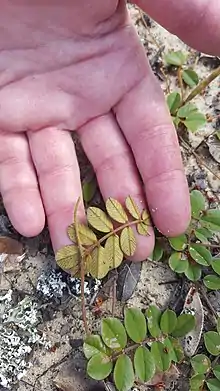Tephrosia mysteriosa
Tephrosia mysteriosa, commonly known as sandhill tippitoes,[1] is a species of legume first described by Kris DeLaney in 2010.[2] It grows on sandhills and is endemic to the Lake Wales and Mount Dora Ridges of Florida.[1][3]
| Tephrosia mysteriosa | |
|---|---|
 | |
| Scientific classification | |
| Kingdom: | Plantae |
| Clade: | Tracheophytes |
| Clade: | Angiosperms |
| Clade: | Eudicots |
| Clade: | Rosids |
| Order: | Fabales |
| Family: | Fabaceae |
| Tribe: | Millettieae |
| Genus: | Tephrosia |
| Species: | T. mysteriosa |
| Binomial name | |
| Tephrosia mysteriosa DeLaney | |
DeLaney collected the type specimen on August 3, 2006 in Carter Creek Preserve, Highlands County, Florida. Each stem of the specimen has up to 9–13 leaflets.[2]
Description
The stems of Tephrosia mysteriosa are prostrate, covered with trichomes (indumentum), and tawny. There are typically 7–11 leaflets per stem; these are approximately 0.5 inches (1.3 cm) long and 0.375 inches (0.95 cm) wide. The leaflets are olive green and elliptical, with strigose hairs on the underside. T. mysteriosa blooms from May to October, with its red buds opening to flowers that are white to light pink in color.[1]
References
- Roger L. Hammer (April 1, 2018). Complete Guide to Florida Wildflowers: Over 600 Wildflowers of the Sunshine State including National Parks, Forests, Preserves, and More than 160 State Parks. Falcon Guides. p. 311. ISBN 978-1-4930-3094-1.
- "Type specimen record: Tephrosia mysteriosa". University of Florida Herbarium. May 10, 2017. Retrieved September 20, 2018.
- DeLaney, Kris. "The Botanical Explorer: Current Issues". Journal of Plant Taxonomy and Botanical Exploration. Retrieved September 20, 2018.